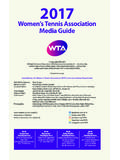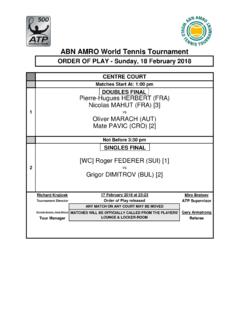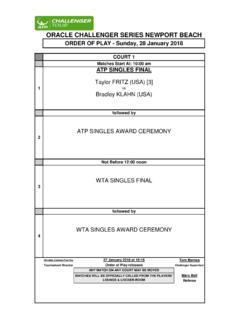Transcription of Table Tennis for PDF - TeachPE.com
1 TableTennisTHE ROYAL MARINES2 CONTENTSPAGEP repared for The Royal Navy in association with the English TableTennis Association and English Schools Table Tennis Association andproduced by Education and Youth Limited, there is any support you feel the Royal Navy can give regarding thisproject please contact 0870 333 notes have been compiled by the English Table TennisAssociation and English Schools Table Tennis Association, theyinclude contributions from:Gail McCulloch, ETTA Vice Chair Coaching, Head of PE, BishopReindorp School, Guildford, Bennett, Sussex County No 1 player and former juniorinternational, Head of PE, Filsham Valley School, Hastings, Holder, ETTA National Team Psychologist, Sports ScienceLecturer, Bishop Otter College of Higher Education, C Gray, ETTA National Development Editor: P Edwards MAThanks also to ITTF for permission to reproduce extracts from TableTennis the Early Years and to Ron Crayden for historical updated August 1999 by:Peter A.
2 Hirst ETTA Coaching Director,with help from Ken Marchant and Notes Teacher NotesINTRODUCTION TO THE MODULE3AN INTRODUCTION TO THE SPORT OF Table TENNIS4 SKILLS DEVELOPMENT SHEET5 UNIT 1 SCHEMES OF WORK6 UNIT 2 SKILLS OF Table TENNIS8 UNIT 3 TACTICS AND UNDERSTANDING OF Table TENNIS16 UNIT 4 ASSESSMENT20 UNIT 5 Table Tennis , LAWS, EQUIPMENT AND OFFICIALS21 UNIT 6 PHYSICAL CONDITIONING26 UNIT 7 MENTAL PREPARATION30 UNIT 8 HISTORY OF Table TENNIS32 UNIT 9 THE STRUCTURE OF Table TENNIS33 UNIT 10 CURRENT ISSUES IN Table TENNIS34 UNIT 11 AWARD SCHEMES36 USEFUL ADDRESSES37 RECOMMENDED READING373 Message from the Governing Bodies of Table TennisThe English Table Tennis Association and English Schools TableTennis Association are working together to promote the developmentof Table Tennis .
3 One of their aims is to provide a Youth Action Planand this project will be part of that overall aim of this module is to provide a valuable resource for teacherswho are unfamiliar with Table Tennis . It provides guidelines whichshould enable teachers to fulfil the demands of the variousexamination module should be considered as a sound basis for understandingand appreciating the skills, techniques and tactics required within thesport of Table English Table Tennis Association and English Schools TableTennis Association are very grateful to the Royal Navy for producingthis resource and hope that teachers find it both user-friendly to the ModuleModule ObjectivesStudents will.
4 Be able to understand, apply and appreciate the techniques, skillsand tactics of the sport relevant to their ability level and within thecontext of the sport show an understanding of, and be able to apply the rules of thesport have an awareness of the structure of the sport at national andinternational level be able to interpret within the context of the sport the theoreticalconcepts which underlie all competitive will: be able to present the techniques, skills and tactics of the sport ina safe and educationally sound environment be able to assess student performance accurately and objectively be able to apply and officiate the rules of the sport as appropriateto the level of performance of their students have a clear understanding of the structure of the sport and aknowledge of where to obtain additional information be able to interpret the theoretical concepts which underlie allsport to increase their students understanding and appreciation ofthe sport of Table Introduction to the Sport of Table TennisAn
5 Olympic sport since 1988, Table Tennis is fast becoming thelargest indoor participation sport in the true Sport For All , Table Tennis is great for young and old, male orfemale, fit and not so fit, able-bodied and disabled. In fact, anyone canplay Table is easy to set up, relatively inexpensive and a healthy and safeactivity, combining concentration of the mind with co-ordination of thebody. And it s great fun!As a school activity, Table Tennis can be particularly attractive for thefollowing reasons: excellent use of space (4 tables on space equivalent to onebadminton court up to 16 players) girls can play equally with or against boys not weather dependent versatile sport (easy to set up, played in sports halls, gymnasia,dining rooms, classrooms, etc.)
6 Early success rate for players (basic skills can be easily learntand pupils can gain early enjoyment) Table Tennis support available (large network of juniorcompetitions and clubs to join. Advice on coaching, setting up aclub, forming a team, applying for grants, etc.) English Schools Table Tennis Association (competition networkstarting at local level)Glossary of TermsIt should be noted that there are different ways of describing TableTennis strokes. For example, the block may be referred to as the half-volley; backspin may be referred to as the slice, or called a basic pushor an advanced chop.
7 Topspin may be called a basic drive or anadvanced descriptions provided in Unit 2 of this work provide cleardefinitions as used by the this text the following abbreviations/terminology are used:F-ForehandB-BackhandFD-Forehand DriveBD-Backhand DriveFP-Forehand PushBP-Backhand PushTUS-Technical Unit For Sport (Sports Council)NVQ-National Vocational QualificationVQ-Vocational QualificationITTF - International Table Tennis FederationETTA - English Table Tennis AssociationTrajectory Flight path ( of the ball)Notes1. All illustrations and explanations refer to a right handed The tables have been illustrated as transparent to enable teachersto see the correct position of the who uses mainly top spin shots close to the Hitter/BlockerPlayer who uses mainly drive and block shots very close to who uses mainly back spin and defensive shots away fromthe TableCompetition using several tables where after an agreed time limit.
8 Winning players on each Table move up one Table and play a newopponent and losing players move down and play a new path of the ballRegular path of the ball5 Name of ModuleTable TennisBasic SkillsThe grip, ball control, service, return of service, backhand push, backhanddrive, forehand push, forehand drive, block, loop chop (pages 8-15)Game-play SkillsConsistency and patience. Good quality and variety of shorts. Good recovery(page 18)Tactical SkillsPlay to own strengths and opponents pace, spin, direction of ball. Variation on strokes. Anticpation (pages16-19)Training SkillsMuscular endurance, cardiovascular endurance, strength, flexibility (pages20-29).
9 Mental preparation (page 30)RulesCopies of the laws can be obtained from: English Table Tennis Association(ETTA) (see page 37 for address).The beginning stage of Table Tennis is the exploratory phase, wherethe player is attempting to learn the correct sequence of movementsof all the basic skills service return, forehand drive. A number oferrors may be made and players will need feedback to recognise andcorrect these errors. Initially a player may not be able to keep a rallygoing across the Table and self-feeding may be necessaryDuring the intermediate stage the basic skills will be performed moreconsistently, and with more quality.
10 Timing and anticipation willimprove, although skills may break down under pressure of a the advanced stage all basic skills are automatic and are preformedwith quality. Players can concentrate on more detailed aspects of theskill and the tactics Development Sheet6 UNIT 1 Schemes of Work1. The recommended scheme of work is both skills and gamesunderstanding based and is progressive, although the sessionsmay be mixed about according to the groups The scheme of work is for 12 lessons, progressing from a base ofno previous knowledge. The scheme may be modified to suit theparticular needs of any The laws of Table Tennis covering play should be introduced in alogical sequence each session.






![Hiroyasu EHARA (JPN) [3] Naoki TAJIMA (JPN) - …](/cache/preview/7/f/9/8/0/0/7/1/thumb-7f9800713cd9140ddeef8a67314a4f53.jpg)

